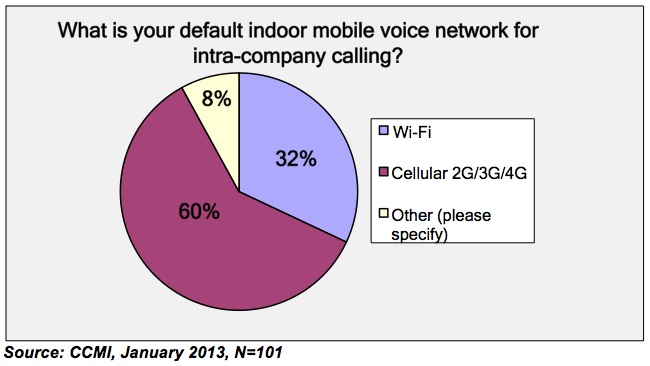- A TechNote on Wireless and Mobility
- Joanie M. Wexler
- Technology Analyst/Editor
You'd think that the enterprise's growing infatuation with mobility management would have yielded specific policies designating a default mobile network for making in-building business phone calls. After all, your decision about whether you use the public cellular network or a private Wi-Fi network as your primary platform for internal voice calling impacts several enterprise mobility decisions.
Yet it turns out that most enterprises don't have any such policy. A whopping 78% of 101 enterprises surveyed don't specify which network employees should use for mobile voice, according to a recent enterprise poll conducted by the Center for Communications Management Information (CCMI).
Pick a Network, Any Network
You might wonder why the choice of network matters. Well, the indoor mobile network you use for voice for the majority of your users has a whole domino effect on network investment decision-making.
For example, the network that the voice application rides should be the one in which you invest significantly to optimize coverage, capacity and quality of service (QoS). The latency, jitter and loss requirements for voice are much more stringent than they are for data, so it's critical to traffic-engineer whichever network is the official, heavily loaded "voice network" for the highest possible mean opinion score (MOS), or call quality. Another reason to specify a default network for voice depends on whether your company's cellular contract has you paying metered charges for intra-company calling - something you might wish to avoid.
Enterprise Reasoning
The user experience figures largely in enterprises' rationale, according to the CCMI poll. For example, the biggest reason for not having a policy, cited by 36% of respondents, was that employers want workers to use whatever network they're most comfortable with. Fair enough. Usability should be the top consideration when trying to optimize productivity and efficiency with mobility.
But, then, do you build out your Wi-Fi network to sufficiently handle large-scale voice call volumes, as well as your in-building cellular network, which requires equipment from each carrier you wish to support? Could get expensive, particularly since BYOD trends mean you'd likely have to support at least the top two, if not all four, of the primary U.S. cellular carriers.
Other reasons for a lack of policy: 28% of the no-policy crowd said that since users already have desk phones, there's really no need for local voice mobility. (Really?) A quarter of those without a policy (25%) said they simply haven't given the issue much thought.
Another 12% cited "other" reasons. Among these reasons were that survey takers were currently in the midst of researching mobile voice solutions or enhancing their Wi-Fi to successfully support large-scale voice over IP (VoIP).
Cellular Is On Top

Of those that do have a default network policy for on-premises voice calling, most (60%) specify cellular as the access network (see figure). Only about half as many respondents (32%) said Wi-Fi was their default mobile voice network. One reason might be that voice-over-Wi-Fi calling requires a special softphone application, adding another layer of complexity to the setup. The remaining 8% picked "other," but didn't specify a network type other than to say they were using PBX extension/unified communications capabilities from their PBX suppliers for indoor voice calling.
Two thirds of those who had put a stake in the ground for cellular as the default network said the reason was that employees are accustomed to using their cell phones when on the go, and that they didn't want users to have to change their mobile behavior (and presumably suffer some productivity losses) when communicating inside the building. Again, a good reason.
The reasons selected for defaulting to Wi-Fi had to do with Wi-Fi network usage being "free" and employers not having to worry about the usage meter running up unpredictable charges (57%). A related reason was that some organizations (29%) want to get maximum ROI for the Wi-Fi network they have built: the more applications that run on the network and the more connections it has, the more valuable it is.
The other primary reason for defaulting to VoIP over Wi-Fi is an obvious one: 29% of respondents said they have poor in-building cellular coverage and thus Wi-Fi phone calling is simply a more reliable approach.










